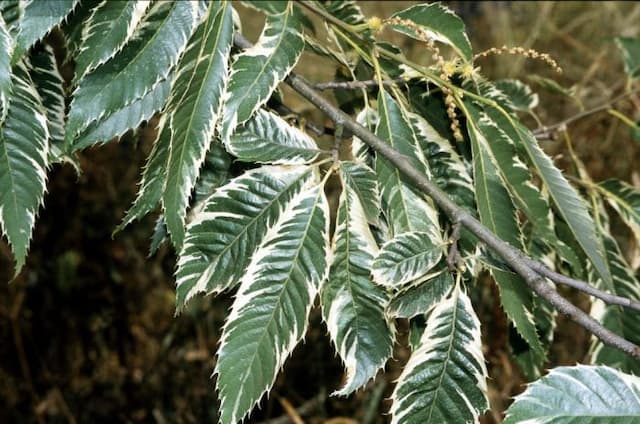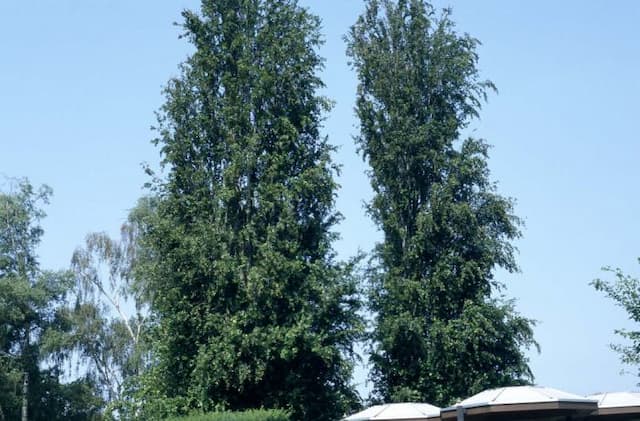European beech Fagus sylvatica 'Dawyck Gold'

ABOUT
The European beech, more specifically the 'Dawyck Gold' variety, is noted for its striking appearance. This distinctive tree has a columnar or fastigiate growth habit, which means it grows in a somewhat narrow, upright shape. The foliage of 'Dawyck Gold' is what really sets it apart, especially during the spring season when the leaves emerge. The young leaves are a vibrant golden color, adding a bright, luminous quality to the landscape. As the seasons change, the leaves evolve in color. Over the summer months, the bright golden hue transitions to a more subdued green with golden edges, blending the various shades for a two-tone effect. Then, in the fall, the tree puts on a final show as the leaves turn into a mix of copper and yellow tones, before shedding them for the winter. The leaves themselves are smooth with wavy edges and have a typical oval shape with a pointed tip, which is characteristic of the European beech. They are arranged alternately along the branches, creating a dense canopy that can provide substantial shade. The bark of the 'Dawyck Gold' European beech is smooth, with a greyish hue that offers a beautiful contrast against the vivid foliage. Overall, 'Dawyck Gold' is a stunning choice for those looking to add vertical interest and year-round color to their gardens, without taking into account its specific size dimensions.
About this plant
 Names
NamesFamily
Fagaceae
Synonyms
Dawyck Gold Beech, Golden Dawyck Beech, Dawyck Gold European Beech
Common names
Fagus sylvatica 'Dawyck Gold'
 Toxicity
ToxicityTo humans
European beech (Fagus sylvatica) including the 'Dawyck Gold' cultivar is not considered toxic to humans. There are no well-documented cases of poisoning from ingesting parts of this tree. Consequently, there are no specific symptoms associated with poisoning from this plant species as it is generally regarded as non-toxic.
To pets
European beech, in general, is not known to be toxic to pets either. The 'Dawyck Gold' cultivar is not associated with toxicity in pets, and no specific symptoms of poisoning have been reported from the ingestion of any part of this plant. Pets that consume plant material may experience digestive upset, but this is not specific to the toxicity of the plant.
 Characteristics
CharacteristicsLife cycle
Perennials
Foliage type
Deciduous
Color of leaves
Golden
Height
50 feet (15 meters)
Spread
10 feet (3 meters)
Plant type
Tree
Hardiness zones
5
Native area
Europe
Benefits
 General Benefits
General Benefits- Ornamental Value: The Fagus sylvatica 'Dawyck Gold', commonly known as the European beech, has striking golden foliage that adds aesthetic appeal to landscapes.
- Seasonal Interest: This cultivar offers vibrant seasonal color changes, from bright green in spring to golden yellow in the fall.
- Shade Provider: As a tall tree, it can provide ample shade, creating cooler areas in gardens and parks during hot summers.
- Wildlife Support: The tree produces beech nuts, which are a source of food for various birds and mammals.
- Low Maintenance: Once established, the European beech requires minimal care, making it a convenient choice for busy gardeners.
- Longevity: Beech trees are known for their long lifespan, providing benefits for many years.
- Erosion Control: The extensive root system of the beech tree helps to stabilize soil and prevent erosion.
- Privacy Screen: With its dense foliage, the European beech can be used as a natural privacy screen in landscaping.
- Architectural Interest: Due to its columnar growth habit, it can be used in formal gardens or to create architectural interest.
- Cultural Significance: The beech tree often has historical and cultural significance, making it a heritage tree in certain regions.
 Medical Properties
Medical PropertiesThis plant is not used for medical purposes.
 Air-purifying Qualities
Air-purifying QualitiesThis plant is not specifically known for air purifying qualities.
 Other Uses
Other Uses- The European beech 'Dawyck Gold' wood is highly valued in woodworking for its versatility, being used for furniture, flooring, and turned objects due to its fine grain and workability.
- Its dense wood has a history of use in tool production, particularly in the crafting of planes, chisels, and other precision instruments that require a hard, stable material.
- The tree's wood serves well in the manufacturing of musical instruments, offering good acoustic properties for pianos, wind instruments, and violin bow making.
- Culinary smokers often seek out beech wood, including that from 'Dawyck Gold', for its subtle, delicate smoke flavor which is ideal for smoking fish, pork, and cheese.
- Woodchips from the European beech are used in gardening as a mulch to regulate soil temperature, retain moisture, and reduce weed growth around plants.
- In the art world, beechwood, including that from 'Dawyck Gold', is used as stretcher bars for canvas paintings, providing a stable and durable frame.
- Small branches or leaves can be used in crafts, such as wreath making and dried floral arrangements, adding a unique golden hue to the designs.
- Veneer produced from the 'Dawyck Gold' beech wood is often used in marquetry and inlay work, adding a decorative element to fine furniture and interior woodwork.
- The sawdust from 'Dawyck Gold' can be used as a base for growing certain types of mushrooms, which prefer the beech wood as a substrate.
- Beech mast, the tree's nuts, can be used as feed for wildlife in managed landscapes, parks, or rural areas to promote biodiversity.
Interesting Facts
 Feng Shui
Feng ShuiThe European Beech is not used in Feng Shui practice.
 Zodiac Sign Compitability
Zodiac Sign CompitabilityThe European Beech is not used in astrology practice.
 Plant Symbolism
Plant Symbolism- Strength and Endurance: As a variety of the European beech tree, the Dawyck Gold symbolizes strength and endurance due to the hard and solid nature of beech wood, suggesting resilience over time.
- Wisdom and Knowledge: The beech tree is often associated with wisdom and knowledge, as beech tablets were historically used for writing in many ancient cultures.
- Patience: Reflecting the slow growth habit of the tree, the Dawyck Gold variety represents patience and the rewards that come with taking time to grow and mature.
- Prosperity: The lush golden hue of the Dawyck Gold's foliage can be symbolic of wealth and prosperity—a visual symbol of abundance and richness.
 Water
WaterThe European Beech, specifically the 'Dawyck Gold' variety, should be watered deeply once a week during its growing season to promote root growth. In the absence of rain, provide about 1-2 gallons of water per square yard of soil around the tree's base, ensuring that moisture reaches well into the root zone. During periods of drought or extreme heat, increase watering to twice per week. In the fall, reduce watering to help the tree harden off for winter. Watering should be done in the morning to allow excess moisture to evaporate throughout the day, reducing the risk of fungal diseases.
 Light
LightThe 'Dawyck Gold' European Beech prefers a sunny spot that receives full to partial sunlight. Ideally, it should get at least 4-6 hours of direct sun daily, which encourages the best leaf coloration and growth. While the tree can tolerate some shade, too much can lead to reduced vitality and may affect its striking golden foliage.
 Temperature
TemperatureThe 'Dawyck Gold' European Beech thrives best in temperate climates and can withstand temperatures as low as -20°F to -30°F and as high as 90°F to 100°F. However, the ideal temperature range for this tree is between 50°F and 75°F. Proper mulching can help protect its root system in both the heat of summer and the cold of winter.
 Pruning
PruningPruning the 'Dawyck Gold' European Beech is necessary to maintain its shape and remove any damaged or diseased branches. The best time to prune is late winter or early spring before new growth begins. This tree should be pruned every 2 to 3 years, focusing on thinning out the canopy to allow light and air to reach the inner branches, and to cut back any branches that are crossing or growing inward.
 Cleaning
CleaningAs needed
 Soil
SoilThe European Beech or 'Dawyck Gold' prefers a well-draining, fertile soil with a slightly acidic to neutral pH, ideally ranging between 5.5 and 7.0. A good soil mix can be created by combining loam, compost, and coarse sand to improve drainage and fertility. Regular amendment with organic matter can help maintain soil health and structure.
 Repotting
RepottingThe European Beech or 'Dawyck Gold' typically does not require frequent repotting as it is a slow-growing tree. It should be repotted only when it has outgrown its current space, which may occur every few years. Young trees can be repotted more frequently, every 2-3 years, to encourage growth, while mature trees may only need repotting every 4-5 years.
 Humidity & Misting
Humidity & MistingThe European Beech or 'Dawyck Gold' is adaptable to a range of humidity conditions but thrives best in moderate to high humidity environments. It prefers outdoor conditions where the surrounding humidity naturally fluctuates. However, it does not require specific humidity adjustments when planted in the ground outdoors.
 Suitable locations
Suitable locationsIndoor
Grow 'Dawyck Gold' in bright light, high humidity, and cool temperatures.
Outdoor
Plant in well-drained soil, full sun to partial shade, protect from strong winds.
Hardiness zone
4-7 USDA
 Life cycle
Life cycleThe European beech 'Dawyck Gold' begins its life cycle when a seed germinates in favourable soil conditions, typically requiring a well-drained and slightly acidic to neutral pH substrate. Upon germination, it grows into a small seedling, developing its characteristic golden foliage as it photosynthesizes and matures. The seedling stage is followed by a prolonged juvenile phase where the tree increases in height and girth, establishing a strong root system. As it enters maturity, 'Dawyck Gold' starts to produce reproductive structures, with flowers that are wind-pollinated, leading to the development of small, triangular beech nuts. These nuts are then dispersed, often by wildlife or gravity, to initiate new life cycles. The mature tree can live for several hundreds of years, slowly growing taller and broader, marking its final stage before senescence and eventual death.
 Propogation
PropogationPropogation time
Early Spring
Propogation: The Fagus sylvatica 'Dawyck Gold', commonly known as the European beech or 'Dawyck Gold' beech, is a stunning ornamental tree valued for its golden foliage and upright growth habit. The most popular method of propagation for this beech variety is by grafting, which is best performed in late winter or early spring, just before active growth begins. Grafting involves taking a healthy scion, which is a young shoot or twig, from the 'Dawyck Gold' beech and joining it onto a compatible rootstock, commonly from another Fagus sylvatica variety. The cut surfaces of both the scion and the rootstock are carefully matched and bound together, allowing the vascular tissues to fuse as the graft heals. This technique is favored because it ensures the new trees maintain the distinctive characteristics of the 'Dawyck Gold' cultivar. Grafted beech trees generally take several weeks to heal and require careful management, including protection from harsh environmental conditions and adequate water and nutrients to encourage successful establishment.









